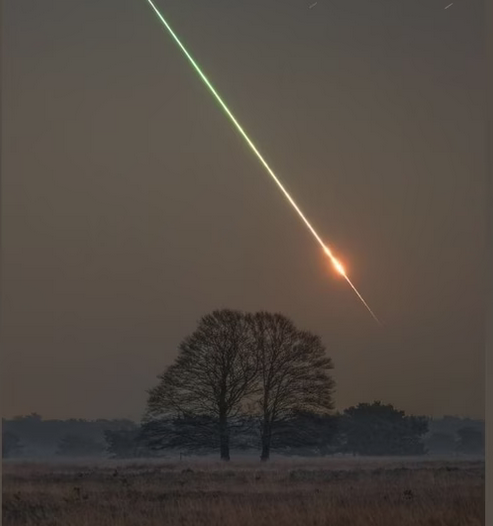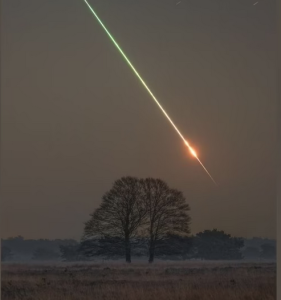Jewels From Space: Who Owns A Meteorite If It Lands On Your Property In The UK?
23rd Feb 2023
Meteorites are fragments of cosmic bodies, and there are thousands of such bodies in our solar system alone. Scientists say that hundreds of such rocks crash into the Earth every day, but most of them are so small that they burn up in our atmosphere without a trace. What happens to those that manage to reach the surface? Earlier, we already wrote about the consequences of large asteroid falling to Earth. But even a small meteor breaking up in the atmosphere or hitting the Earth can leave meteoroids that we can find. This article will focus on the little guests from outer space. You will find out how to identify a meteorite, who owns a meteorite if it lands on your property in the UK, whether you can sell it and whether it is really possible to get rich this way.
Meteorite ownership law in the UK
English law provides that a meteorite is the property of the landowner, and there is no obligation to report one’s discovery. However, buried meteorites may fall under mineral rights. The law on the ownership and control of meteorites discusses this aspect in detail.
Who has the rights to a meteorite?
It is a general principle of English law that if anyone owns a house or land which he occupies and over which he shows the intention of exercising control and preventing unauthorized interference, and something is found in that house or land by a stranger or a servant, possession of the object found is with the owner locus in quo. Simply put, if a meteor lands on your property in the UK, it will belong exclusively to you, although no United Kingdom decision has dealt with such an issue.
If the meteorite were legally characterized as a “treasure trove,” then under common law, it is the property of the crown on the basis that the unknown original owner, who hid the treasure long ago, gave it to the crown after death. But since the new find of the meteorite was never intentionally hidden by anyone, it is unlikely that such a condition would apply.
So, can you keep a meteorite if you find it in the UK? Without any problem. There is only one trifle left to do — find it in your backyard.
What are the two types of meteorites?
Meteorites are divided into two main classes according to their detection method: fallen and found. In the first case, a flying fireball (meteor) is observed directly. You fix the time and duration of the phenomenon, run to the crash site, and discover the remains. In the second case, you find a meteorite on the Earth’s surface, and no one has seen it fall.
Where and how to find meteorites in the UK?
Scientists claim that about 16 tons of meteorites weighing from 50 g to 10 kg fall down on Earth every year. This estimate does not include smaller stones and dust, which bombard our planet every second. You are unlikely to discover them, anyway.
To date, the number of all meteorites found on Earth is about 70 thousand. Antarctica is the best place to find them. The reason is simple — the stones that have fallen on the ice are clearly visible. They stay longer on the surface and are, therefore, easier to find. But there aren’t too many meteorites in the UK. As of 2013, only 44 celestial rocks have been officially discovered there. Below you can see a map of where they were found.

The last known meteorite in the UK fell near the town of Winchcombe in Gloucestershire on 28th February 2021. More than half a kilogram of debris was collected in the vicinity, which were handed over to scientists for further study.
Still, do not despair. Meteor showers over the UK are observed with enviable regularity, which means that there is always a chance to find a space guest at the supposed place of impact. The Natural History Museum in London leads and manages the United Kingdom Fireball Alliance of Great Britain (UKFAll), which uses a vast network of 186 cameras monitoring the sky over the UK and capturing the fire trails of meteors. By the way, you can use them not only to track potential crash sites, but also to help in the search by connecting your personal camera to the system.
How to identify a meteorite
Every day, meteorite hunters around the world find hundreds of rocks, but only a few of them actually turn out to be guests from outer space. So, what can help you determine that you are looking at a real meteorite?

Fused
Meteorites often have a thin, shiny black coating known as a melted crust. It results from friction with the atmosphere. But be careful not to confuse this with desert lacquer, a reddish-brown coating, which is a build-up of clay, rust, and fungus that often grows on terrestrial rocks.
Covered with regmaglypts
Regmaglypts are peculiar imprints on the surface of meteorites, looking as if someone took wet clay and pressed it too hard. However, it is worth considering that the longer the stone is on Earth, the higher the likelihood that it will lose these signs as a result of weathering, contact with water, etc.

Irregular shaped
Meteorites are hardly ever perfectly round, so spherical pebbles are not good candidates for further study.
Widmanstätte structured
If the stone is large enough for you to saw off a piece, do so. The cut trace of a meteorite will most likely have a Widmanstätte structure — a pattern in the form of plates with a geometrically regular shape. Such a pattern occurs if, at low temperatures in space, two crystallizing minerals cannot mix. Interestingly, all attempts to create Widmanstätten patterns in the laboratory have, so far, failed.

Has no bubbles
Visible bubbles most likely indicate that a stone is not a meteorite. Bubbles usually form in volcanic rocks when the gas expands as the magma cools and solidifies, which means the mineral is most likely terrestrial. Although both the Moon and Mars once experienced volcanic activity, meteorites from these bodies are extremely rare on Earth; we mostly get fragments of asteroids.
Heavy
Due to their high metal content, iron meteorites are 3.5 times heavier than regular Earth rocks of the same size, and stony meteorites are about 1.5 times heavier, according to the University of New Mexico Meteorite Museum. However, it is not enough to say that your stone is heavy. Its density must be quantified by dividing mass by volume.
Magnetized
Most meteorites are rich in iron and nickel and therefore have magnetic properties. But even if your stone is magnetized, this does not make it a meteorite. You might as well have the mineral magnetite in your hands, and some meteorites, including achondrites, lunar and Martian rocks, contain very little metal, thus lacking magnetic properties.
Who can authenticate my meteorite?
As you already see, all the above signs do not give a 100% guarantee that you have found a meteorite. So, if the discovery is very important for you and you want to know for sure, you better seek professional help.
You may try contacting your local Geological Survey, college or university or a natural history museum. Also, there are several commercial firms that will examine and identify suspected meteorites for a fee.

What to do if you find a meteorite?
First, pick up the meteorite using clean gloves, tongs, or new aluminium foil. Simply tear off a fresh piece of foil from the roll and use it to lift the meteorite. Never pick up a recently fallen meteorite with your bare hands. The grease and germs from your skin will slowly break down the meteorite’s surface, contaminating it and causing it to rust. The contamination aspect is especially important for carbonaceous meteorites and other unusual types.
Next, keep the stone clean and dry. You can keep it wrapped in foil for as long as you need, and you can also place it in a sealed bag with a desiccant to protect it from atmospheric moisture.
In the end, you can keep the stone as a souvenir, donate it to one of the scientific organizations for meteorite studies, or … sell it.
Who buys meteorites and how much do they cost?
Meteorites are bought at international exhibitions, auctions, well-known online sites and even in antique stores. How much can you sell a meteorite for? Prices vary greatly and will largely depend on meteorite composition, size, weight, and attractiveness. The most expensive ones come from the Moon and Mars because they are so rare. One gram of such a rock can be valued at $1,000 or more. An iron meteorite can be sold at 0.5-5 dollars per 1 gram, and a stone meteorite will cost from 2 to 20 dollars per gram.
Since the meteorite material is unique and rare, many enterprising people make a business of it. Processed meteorites often act as precious stones in jewellery, and they are sought after by collectors who are ready to pay enormous sums for a unique stone.

Conclusion
Now that you know who owns a meteorite in the UK and how to identify a meteorite, shouldn’t you pick up a meteorite metal detector and go searching for jewels from space in your backyard? Who knows, maybe you will replenish your family budget or just discover a great item to surprise your house guests.






Thank you for your comment! It will be visible on the site after moderation.